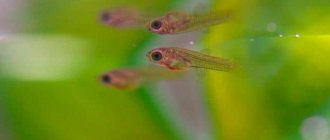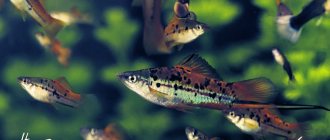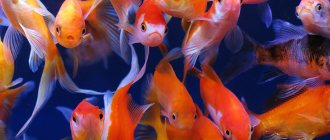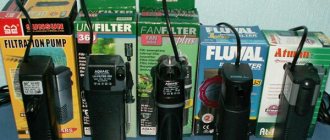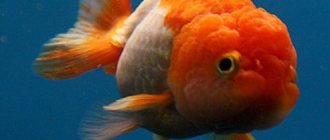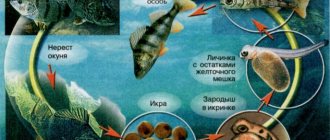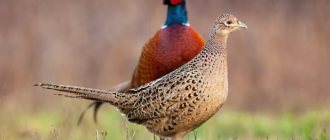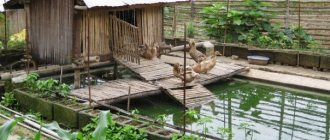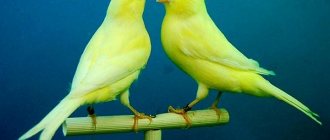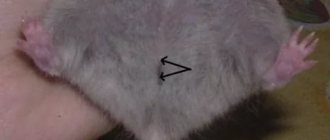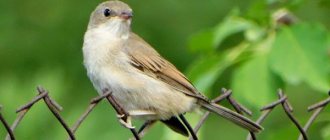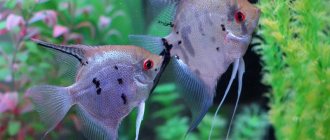Goldfish
Reproduction of goldfish is an interesting and at the same time very labor-intensive process. Which requires the aquarist to have a certain level of skills and knowledge. Goldfish are one of the most common aquarium fish species. Today, this type of aquarium fish can be purchased at almost any pet store. However, in the recent past, namely at the end of the 19th century, only rich and noble people could boast of an aquarium with such inhabitants.
Goldfish first appeared in Europe in the 17th century. It is believed that this type of aquarium fish was originally actively bred in China. There are many types of goldfish, which have different shapes of their bodies, as well as the length of their fins, bodies, and also have different color scales.
Types of goldfish - comet, redcap and telescope (from left to right).
Conditions for keeping goldfish
In order for fish to reproduce successfully in an aquarium, it is necessary to create favorable conditions. Since this is not a viviparous species, you should select a tank for spawning and equip it with good aeration, powerful filtration, and lighting. Safe decorations and plants will create a private environment for the fish.
The temperature of the spawning water in the aquarium should not exceed 28°C; you can use an aquarium cooler. It is believed that the optimal temperature parameters depend on the body length of the goldfish:
- types of elongated shape - 15–25°C;
- short-bodied breeds - 22–28°C.
Attention!
It is important to avoid sudden changes in temperature.
Goldfish are one of the oldest aquarium fish.
Other maintenance patterns include seasonal changes. In summer, the water temperature in the spawning area can be several degrees higher than the minimum values, and in winter lower.
It is recommended to add table salt to the water, a concentration of 5–10%. Fish are not demanding on chemical parameters. The optimal values do not differ from those recommended for main maintenance outside the spawning period.
| Acidity, in, pH | 6.0 – 8.0 units |
| Hardness, in dGH | 8 – 25 units. |
Water renewal (1/3 of the volume) is carried out weekly. The bottom is siphoned and the filter is cleaned first. Water is poured with settled water (1–2 days) or running water, but purified with special reagents (Tetra AquaSafe, AQUAYER AntiToxin Vita, etc.). To check liquid parameters, you can use aquarium water tests.
Determination of sex and isolation of pairs for reproduction
Young individuals are able to spawn already in the first year of life. However, it is better to breed goldfish with more mature pairs. They reach full development at 2–3 years. It is at this age, during the spawning period, that one can accurately determine the gender of a flock:
- The male has white tubercles on the gill covers, and the edges of the pectoral fins form a sawtooth edge.
- The female may also exhibit such signs, but she is distinguished by her body shape. The abdomen becomes asymmetrically rounded as the eggs mature, and the body becomes curved.
Behavioral characteristics of males are the pursuit of females. Representatives of the fairer sex are always indifferent and do not show any activity.
Several fish are taken into the spawning grounds at once - one female and 2-3 males, so that they are sure to give birth to offspring. It is recommended to isolate breeders in the early evening for better adaptation.
Suitable neighborhood
Oranda is usually kept in a separate (species) aquarium. A clumsy and slow fish cannot resist active, curious species (barbs, irises, etc.), which will pursue orandas and spoil their luxurious tails and fins. You should not add large oranda fish to small fish that can fit in the mouth of a goldfish.
But they can find suitable neighbors from the same slow-moving aquarium inhabitants:
telescopes
veiltails
Shubunkins
Ancitrus catfish will also be suitable neighbors. Peace-loving creatures hide in shelters during the day. To prevent voracious orandas from taking food from the catfish, you need to feed the ancitrus in the evening, throwing them bottom nutritional tablets before turning off the lights.
Imitation of spring conditions and selection of pairs
In artificial conditions, fish are able to reproduce all year round; in nature, the spawning period begins in the spring. This time of year can be simulated by gradual changes in water temperature.
Stages of simulating spring conditions:
- Gradually lower the water temperature to 10–12°C in the main aquarium.
- The cooling process is stopped and the water is allowed to warm up under natural room conditions to 18°C.
- The fish are transplanted into a spawning tank with the same water temperature - 18°C.
- Every day, the water temperature in the spawning tank is increased by a couple of degrees until the required parameters are reached in accordance with the time of year.
Before placing goldfish for spawning, suitable individuals should be selected for productive mating.
The main requirements for producers are full compliance of the species with breed standards. If this indicator does not matter, choose males who are most active in relation to the opposite sex. Large females are preferred. Its left side of the body should have a protrusion, and the anal fin area should become noticeably thicker. When a fish is pregnant, it becomes inert and moves heavily.
Swordtails
Swordtails belong to the family of viviparous toothed carps. The body is elongated, flattened laterally.
The natural background color of males is light brownish-olive, with a green tint on the back. A two-millimeter red stripe runs along the sides, and below and above it there are two more narrow red stripes. The long lower ray of the caudal fin (sword) has a clear black edge. The color of the female is much paler, the body has a silvery sheen, the middle of the body is occupied by a wide stripe, and below and above this stripe there are two more narrow stripes 0.5 mm wide.
The male's body (without the sword) can grow up to 8 cm, and the female's body up to 12 cm.
Editorial: Carpet Eleotris
Swordtails live up to three to five years.
Sword bearers VIDEO
Breeding process
After the pair is isolated, spawning begins a few days later, at dawn. Lasts up to approximately 6 hours. In the spawning area, the male’s activity increases. During the courtship period, he begins to make frequent blows with his snout to the area of the female's anus. This is a distinctive sign of how to understand that the female is preparing to spawn.
The male, with rapid movements, tries to drive the female into a corner. When he succeeds, the pregnant goldfish begins to spawn eggs. Males immediately water the eggs with seed for fertilization. The female lays 10–20 eggs at a time. The cycle is repeated and lasts from 2 to 3 hours. Immediately after this, the producers are removed from the spawning area.
Method of artificial fertilization of eggs
It is not always possible for the male to naturally fertilize the eggs. In this case, the fish is transplanted into a small tank, carefully taken into the hand and the area of the genitourinary opening is stimulated with a slight movement of the finger. This effect lasts about 30 seconds and allows the sperm to be released.
It is better to carry out the manipulation in close contact with water so that the biomaterial immediately ends up in the tank. The resulting sperm along with water is poured into a spawning tank with spawned eggs. To distribute the biomaterial evenly, stir the water and wait for the larvae to appear.
If goldfish do not spawn, reproduction is stimulated by a pituitary injection into the upper part of the body.
| Acetonated pituitary gland, amount of dry matter, mg | ||
| Weight of fish, in g. | Males | Females |
| 30-50 | 0,3 | 0,1 |
| 50-80 | 0,4 | 0,2 |
| 80-110 | 0,5 | 0,3 |
| 110-149 | 0,6 | 0,4 |
| 140-170 | 0,7 | 0,5 |
Biomaterial is taken from individuals artificially. The female is taken out of the water, the body is wiped with gauze so that the eggs are dry and free of moisture. With light stroking movements along the abdomen, the caviar begins to flow out in a trickle. It is collected in a clean, dry container. The male is also wiped and moisture is removed from the surface of the body. The sperm is collected with an eye pipette, stroking the fish on the sides (direction - from the head to the caudal fin).
The resulting seed is applied to the eggs in drops. It has a liquid consistency and spreads well with the help of a small feather. One drop of sperm can fertilize 5–10 g of eggs.
Inseminated eggs:
- Fill with water (so that it slightly covers the biomaterial), mix with a feather.
- After 2–3 minutes, drain ¾ of the liquid volume, add fresh water, and mix.
- Evenly distributed in the spawning tank.
Placing the eggs separately from each other reduces the chance of fry hatching.
In case of unsuccessful spawning, you can fertilize the eggs manually
Spawning tank
The spawning aquarium should be 90-120 cm in length with a water height of no more than 20-25 cm, i.e. approximately 70-100 liter capacity.
It is necessary to prepare the spawning area at least a week before the release of the spawners. Typically, the spawning tank is kept empty and dry for several weeks or disinfected with chemicals, followed by thorough rinsing. Fill in water to 20-25 cm and start the aerator. The temperature in the tank is 18°C.
The tank prepared for spawning should contain small-leaved plants: elodea, fontinalis, pinnate, hornwort or an artificial substrate: nylon threads, unraveled nylon washcloths, rubber sponges, well-boiled washcloth (not willow). The substrate must be pressed to the bottom.
Feeding the fry
The spawning tank with eggs is constantly aerated and intensively illuminated. The water temperature is maintained between 22–25°C. The larvae begin to hatch on days 2–5 and look like strings with eyes. During the first 2–3 days they move in jerks and attach to plants in an upright position. At this moment, they are practically immobilized and feed on the contents of the yolk sac.
After three days, the larvae are already able to reach the surface of the water. Having filled the swim bladder with air, take a horizontal position. This makes it possible to move and eat freely.
Larvae and fry are fed intensively, every 3–4 hours, the diet is selected taking into account age.
| 1 Week | 2 week | 1 month | 2 month |
| ciliates | nematodes | small bloodworm | small bloodworm |
| rotifer | juvenile daphnia | adult daphnia | chopped enchytraeus |
| juvenile cyclops | adult cyclops | Drosophila | |
| dry food Sera Micron, TetraMin | aulophorus |
From 2 weeks you can add yolk to the diet. It is hard-boiled, crushed in water, wrapped in gauze and hung in a spawning tank.
After a month, the frequency of feeding is reduced to 2 times a day. The fry should not experience an excess or lack of food. Residues of feed and waste products must be removed regularly and the water changed frequently.
The fry are kept in the spawning tank for up to 2 weeks. After this, they are transplanted into a 30-40 liter aquarium. This tank volume is designed for 250 fry.
Goldfish fry quickly become like their parents
Breeding goldfish can present many surprises to the aquarist who seeks to produce “pure breed” offspring. Even careful selection of producers does not guarantee that the fry will exactly inherit the standards of their parents. If the hobbyist is not afraid of possible genetic defects in the brood, breeding goldfish will be a labor-intensive but exciting process.
Was this information useful to you? Share in the comments!
